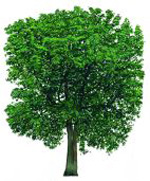Ash: what can be done?
A deadly fungal disease that preys on ash trees is taking hold in Britain. Steven Desmond looks at the causes, and wonders what the future holds for our venerable natives


One of the first tunes attempted by any novice musician, whatever their instrument, is The Ash Grove. If you can't play that, it's time to quit. The words, at least in the English translation, speak of a character wandering pensively in the dark shades of the lonely ash grove. The very idea of such a harmless pursuit is now under threat due to the emergence of a destructive fungal disease that, having sprung fully formed from nowhere, threatens one of our most familiar native trees. There are dark suggestions of foreign imports, ministerial dithering and mass fellings, but it might help if we examine the context for what has happened and the present state of knowledge, as well as considering related events in the past and the present.
The common ash (Fraxinus excelsior) is widespread in Britain, familiar in both town and country, typically seen as a single specimen on a village green, shooting up from a hedgerow, or on the edge of open woodland. In general, it doesn't form woods or forests, preferring to spread its broad crown in the open. It reproduces superabundantly by seed every year, with the dense bunches of ‘keys' hanging from the trees a familiar sight in late summer, each seed framed in an ingeniously shaped curving wing that enables the wind to carry it away from its parent tree in the storms of autumn. The leaves are distinctive, being subdivided into parallel leaflets, and when they fall, the twigs can be readily identified from the pyramidal black buds arranged in opposite pairs. Everyone knows, or used to know, that the excellent timber is traditionally used for tool handles, and that the firewood is the best of all.
The link with the past
Perhaps most importantly from the point of view of our cultural heritage, the ash coppices exceptionally well. Coppicing, after a long period of decline, has revive in recent years, and we now understand, through the work of Oliver Rackham and others, that a coppice ash tree is frequently an indicator of an ancient woodland, and that, because coppiced trees are kept in a constant state of renewal, it's perfectly possible that some of the oldest trees in this gradually being worked out by scientists, which is part of the reason the official reaction appears to have been so slow. Baffling contradictions
It is one thing to say that something must be done, quite another to decide what, and impossible to wash every animal or bird that walks over a fallen ash leaf in autumn. And if an ash tree in a hedgerow contracts the disease, how is it to be removed, roots and all? Every possible course of action throws up, hydra-like, a list of baffling contradictions. Perhaps the most daunting of these is that, now the leaves have fallen, the ash is the last of our native trees each year to put out fresh ones, typically in May, fully six months from now. A lot can happen in six months, and all invisibly.
The elm example
It may be that, in the medium term, we will have to live with this unwelcome arrival. Much has been written, understandably, on the devastation caused by Dutch elm disease in the 1970s and 1980s. I lived at the end of an 18th-century avenue of 100ft English elms and watched them fall and smash miserably on the ground. We now know that the disease has been endemic in this country for many thousands of years.
Exquisite houses, the beauty of Nature, and how to get the most from your life, straight to your inbox.
In time, resistance to the current strain will evolve and the elm will rise again. Not in our lifetimes, nor for others yet to come, but nature takes the long view, and evolution takes time. Similarly, as in countries where ash dieback has become established, some trees show resistance. The same thing will happen here. This may sound like a poor consolation, but ultimately that's how it works. No invasive organism has an interest in making its host extinct. None of us can bear the thought of the demise of ash, one of our most familiar native trees. Learn the symptoms, keep your eyes open and follow the advice of the professionals. If we want our successors to walk in the shade of the lonely ash grove, they will need to look back to the time when we did our best to prevent things getting any worse.
What should I do if I find suspicious symptoms?
If possible, take good-quality digital photographs of the whole tree and close-ups of the symptoms, obtain an accurate description of the location (an Ordnance Survey or GIS reference is ideal), and email them with your report to one of the following: Fera Plant Health & Seeds Inspectorate (01904 465625; planthealth.info@fera.gsi. gov.uk; www.fera.defra.gov.uk/fera/plants/ planthealth)
The Forestry Commission Plant Health Service (0845 933 5577; plant.health@ forestry.gsi.gov.uk; www.forestry.gov.uk/pestsanddiseases)
Country Life is unlike any other magazine: the only glossy weekly on the newsstand and the only magazine that has been guest-edited by His Majesty The King not once, but twice. It is a celebration of modern rural life and all its diverse joys and pleasures — that was first published in Queen Victoria's Diamond Jubilee year. Our eclectic mixture of witty and informative content — from the most up-to-date property news and commentary and a coveted glimpse inside some of the UK's best houses and gardens, to gardening, the arts and interior design, written by experts in their field — still cannot be found in print or online, anywhere else.
